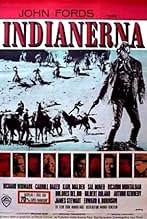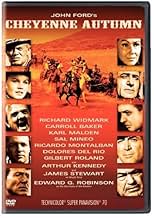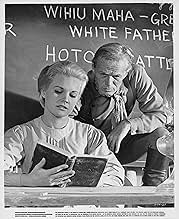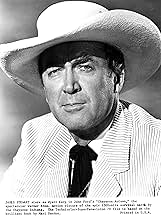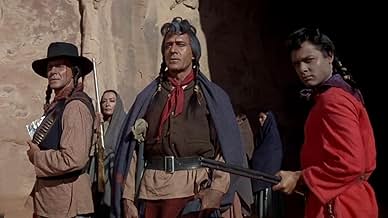Les Cheyenne, fatigués des promesses brisées du gouvernement américain, partent pour leurs terres ancestrales, mais un officier de la cavalerie sympathique à leur cause est envoyé pour les r... Tout lireLes Cheyenne, fatigués des promesses brisées du gouvernement américain, partent pour leurs terres ancestrales, mais un officier de la cavalerie sympathique à leur cause est envoyé pour les ramener dans leur réserve.Les Cheyenne, fatigués des promesses brisées du gouvernement américain, partent pour leurs terres ancestrales, mais un officier de la cavalerie sympathique à leur cause est envoyé pour les ramener dans leur réserve.
- Nommé pour 1 oscar
- 1 victoire et 3 nominations au total
- Spanish Woman
- (as Dolores Del Rio)
- Guinevere Plantagenet
- (as Betty Ellen)
Histoire
Le saviez-vous
- GaffesThe language used by the Cheyenne in this movie is not Cheyenne. It is Navajo. Cheyenne is an Algonquian language, whereas Navajo is Athabaskan (Na Dene), and they do not sound even remotely similar. This is explainable, however, by the fact that this film was shot on the Navajo Nation.
- Citations
Secretary of the Interior: Oh, Henry... you and I fought together at Gettysburg. You had never seen a Negro slave. All you ever knew was that they were human beings with the rights of human beings - and it was worth an arm to you.
- Autres versionsMany television prints run 145 minutes, and omit the scene with James Stewart as Wyatt Earp. The video release is the full 154-minute version.
- ConnexionsEdited into Film socialisme (2010)
For some reason, Ford felt that Latino actors were appropriate for the roles of Native Americans, and Ricardo Montalban, Gilbert Roland, and Dolores del Rio do achieve a measure of dignity as members of the long-suffering Cheyenne tribe. While Carroll Baker tries hard as a Quaker woman who accompanies the Cheyenne on an arduous trek back to their homeland, her bleached blonde hair, immaculate make-up, and voice undercut her efforts. The work of composer, Alex North, also sounds out of place. Best known for his scores for "Spartacus" and "Cleopatra," North's music here evokes Roman legions rather than the U.S. cavalry.
However, the biggest flaw in the film is a misconceived episode in the middle that features James Stewart, Arthur Kennedy, and John Carradine. As Wyatt Earp and Doc Holliday, Stewart and Kennedy perform a comedy routine that jars with the solemnity of the previous scenes. Indeed, the entire Dodge City sequence is a western comedy, and viewers would be justified in thinking that some film reels were mislabeled and an entire sequence from another film had been inserted accidentally. Whatever dignity and concern was established in the film's first hour are destroyed when the action moves from the Cheyenne to Earp and Dodge City.
"Cheyenne Autumn" was likely conceived as a follow-up to the successful "How the West Was Won." John Ford was one of the directors of that Cinerama film; Carroll Baker, Karl Malden, James Stewart, and Richard Widmark are featured in both films; and the ads for the two westerns are strikingly similar. Widmark anchors "Cheyenne Autumn" and provides a narration much as Spencer Tracey did for "How the West Was Won." However, the earlier movie was a rousing adventure with a great score and an uplifting theme of westward expansion. Despite an overture and intermission, "Cheyenne Autumn" is a small, sober tale of racial injustice that has been stretched out and embellished with a jarring music score and a schizophrenic mix of comedy and tragedy that lays waste to some fine epic moments.
- dglink
- 11 nov. 2007
- Lien permanent
Meilleurs choix
- How long is Cheyenne Autumn?Propulsé par Alexa
Détails
Box-office
- Budget
- 4 200 000 $ US (estimation)
- Brut – à l'échelle mondiale
- 10 980 $ US
- Durée2 heures 34 minutes
- Couleur
- Rapport de forme
- 2.20 : 1
Contribuer à cette page




